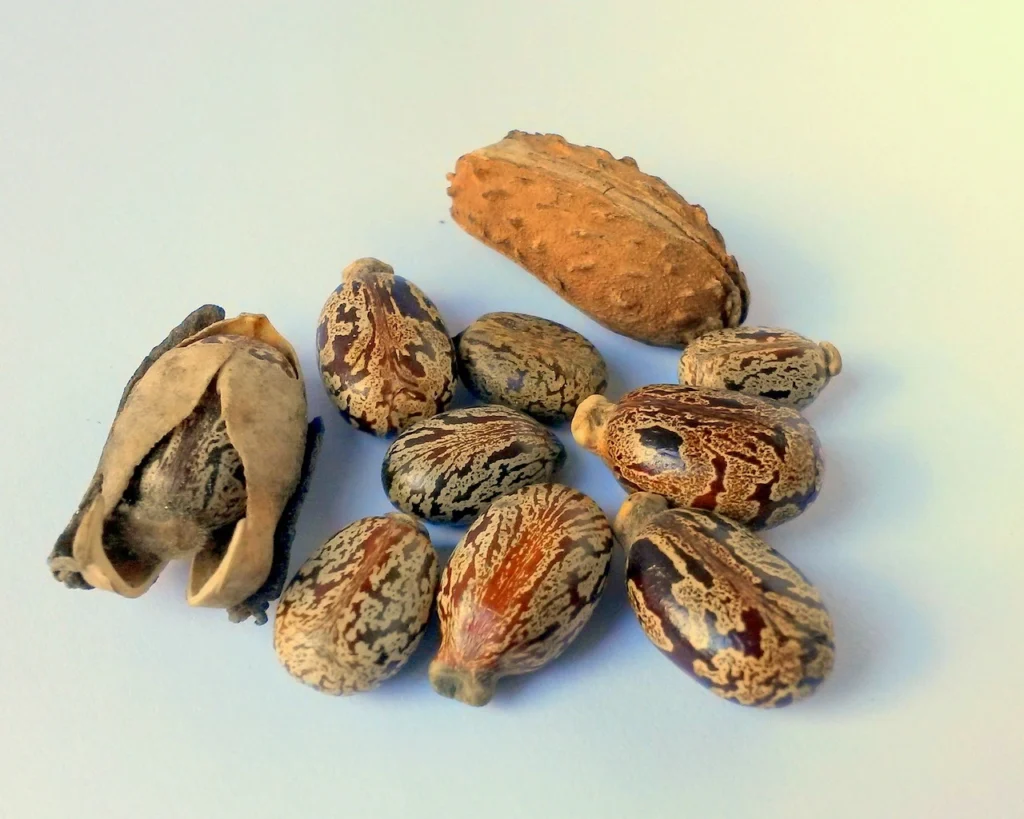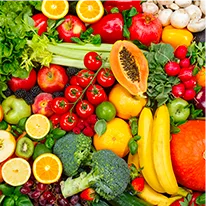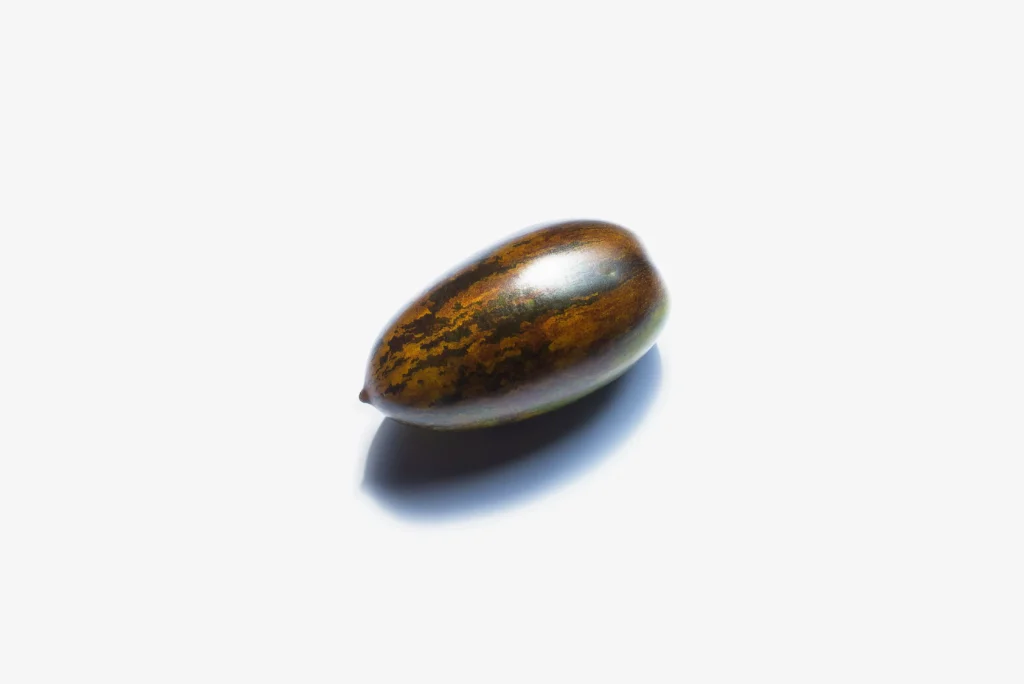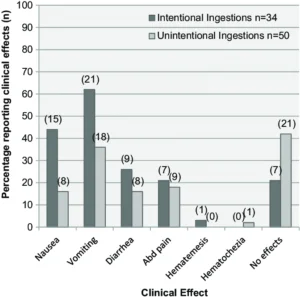Castor Bean Plant Seeds: A Complete Guide

Castor bean plants (Ricinus communis) produce seeds that are an important crop grown for castor oil production. However, the seeds also contain a dangerous toxin called ricin, so safety precautions are critical when handling these seeds.
This guide offers an extensive overview of castor bean plant seeds including details on growing conditions, harvesting methods, seed uses, and necessary handling precautions when utilizing this unique seed crop.
Key takeaways:
- Castor bean seeds contain the toxic ricin compound, necessitating extreme safety precautions like protective gear and decontamination when handling.
- Once detoxified, castor seeds provide valuable castor oil for industries and organic fertilizers from the nutrient-rich seed meal.
- Optimal castor seed cultivation requires warm climates, fertile well-drained soils, and proper planting/harvesting techniques.
- Safe long-term seed storage involves drying to 10% moisture, airtight containers, and cool/dry conditions to preserve viability and oil quality.

Get the latest news and tips from the posts straight to your inbox
Join the 10000+ subscribers for exclusive access to our monthly health newsletter on natural healing
Introduction to Castor Bean Plants
Castor bean plants likely originated in tropical Africa based on fossil evidence, but the exact region is unclear. Historical records indicate early cultivation in Egypt and the Mediterranean region dating back to biblical times. Today castor grows well globally in tropical and subtropical climates.
Botanically classified as Ricinus communis, the castor bean is not a true bean at all. It is a seed from the spurge family of flowering plants (Euphorbiaceae).
Other key details regarding castor bean plants:
- Plant type: fast-growing, annual flowering plant
- Height: Can reach 15 – 18 feet tall at maturity
- Flowers & seeds: Produced on stems in spiny green seed pods containing up to 10 seeds each
- Seed oil uses: Castor oil has a number of industrial applications
- Toxicity: Seeds contain ricin, an extremely poisonous compound
Next we will explore details on the seeds themselves that make castor bean plants so unique.
Castor Bean Plant Seeds Physical Characteristics

Castor seeds are unlike any other crop seed given their distinct physical features and chemical composition:
Size & Shape
- Size range: 1/8 to 1/4 inches long
- Shape: Ovoid shaped with a pointed tip
Outer Coating
- Glossy exterior casing
- Color variations
- Reddish-brown
- Black
- White
- Gray
- Multicolored mixes
Inner Composition
- Seed contents:
- 42–55% oil
- 35% water
- 10% protein
- 4% carbohydrates
- 5% fiber
- 1% ash
- Toxins: Ricin and related cytotoxins
The oil content makes castor seeds extremely valuable, but the ricin toxin also makes the seeds dangerous if improperly handled. Proper growing conditions are essential to optimize castor bean seed production while maintaining personal safety.
Ideal Growing Conditions
Castor grows well in light, fertile soil types in tropical or subtropical climates with consistent warmth. Key growing requirements include:
Climate Conditions
- Warm weather
- Minimum temp > 10°C
- Optimum temp 21–27°C
- Annual rainfall
- Minimum of 30–100 cm
- Optimum of 75–100 cm
- Grows optimally up to 1200 meters altitude
Soil Requirements
- Light, well-drained, fertile soils
- Soil pH between 5.5 and 7.0
- Full sun exposure
Plant Spacing
- Space rows 90–150 cm apart
- Space plants 30–90 cm apart within rows
With adequate warmth and soil moisture castor establishes quickly. Taproots extend deeply to better access soil moisture in drier conditions. Next we’ll review the planting process and seed germination specifics.
Planting & Germination
Castor establishes best by direct seeding into warm soil. Here are key planting and germination guidelines:
Planting Time
- After frost risk has passed
- When soil temperature exceeds 17°C
Planting Process
- Till soil to depth of 15-20 cm
- Dig furrows at desired row spacing
- Place 2-3 seeds every 30 cm within the furrows at 1-2 cm depth
- Cover seeds lightly with soil
- Pack down covering soil
Germination Process
- Seeds swell upon absorbing water
- Radical emerges approximately 5 days after planting
- Emergence: 10-15 days
- Optimal soil temperature for emergence: 20-30°C
- Seedlings grow rapidly given adequate warmth, soil moisture
Thin seedlings to one plant every 30 cm once established.
As plants transition into maturity, monitor them for signs they are ready for harvest.
Harvesting Castor Bean Seeds
Castor seeds ripen at different rates even within the same plant. Plants typically reach maturity and produce seed pods within 3-4 months after planting. Monitor seed pods closely as they near maturity.
Harvest indicators:
- Seed pods turn yellowish and dry out
- Seeds rattle inside the dried pods when shaken
- Seed coats transition to mature color (species dependent)
Harvesting Process
- Carefully cut seed heads from plants by hand one at a time
- Place heads into collection bags
- Transport bags carefully to prevent spilling
- Store picked heads out of moisture until threshing
Thresh pods by hand or with mechanical threshers. Wear appropriate protective garments while handling seeds including gloves, long sleeves, face masks and eye protection.
Castor seeds store safely within cool, sealed containers for up to 5 years without significant deterioration. However, seed oil content slowly declines over extended storage periods.

Get the latest news and tips from the posts straight to your inbox
Join the 10000+ subscribers for exclusive access to our monthly health newsletter on natural healing
Post Harvest Handling & Storage
Due to toxicity precautions, carefully handle and store harvested castor seeds using these protocols:
Drying Seeds
- Dry seeds to safe storage moisture of 10%
- Spread seeds in thin layers
- Use drying fans at 43°C for up to six days
- Monitor moisture content
Storage Containers
- Seal seeds in moisture-proof containers
- Glass, tin or heavily lined bags
Storage Conditions
- Cool, dry room
- Ambient temperatures from 0°C to 25°C
- Relative humidity of 50-70%
By following these post harvest protocols, castor bean seeds store well for extended durations. This allows time for demand to potentially increase for castor seed oil extraction or other usages we’ll explore next.
Castor Seed Uses & Production
Castor seeds serve various applications once harvested and properly processed to prevent toxicity:
The oil rich seeds produce an extremely versatile oil used across industries:
Oil Extraction Process
- Carefully crack seeds
- Heat to allow oil to flow
- Press seeds to extract oil
- Decant and filter oil
- Carefully detoxify oil using one of several processes
Common Detoxification Methods
- Mixing with sodium hydroxide
- Heating to 270°C
- Water washing
- Furfural extraction
With ricin removed castor oil serves as an exceptionally functional industrial oil.
Castor Seed Uses for Fertilizer
In addition to their high oil content, castor seeds also supply key plant nutrients beneficial when used as an organic fertilizer.
Nutrient Composition
- Nitrogen: 3-7%
- Phosphorus: 1-2%
- Potassium: 1-4%
The meal leftover after oil extraction also provides an organic fertilizer option. Integrating castor bean residues or castor seed fertilizers into fields promotes soil health.
Medicinal Applications
Beyond industrial applications, castor oil offers an array of medicinal uses – often used to treat skin conditions and as a laxative. The healing properties come from its high levels of ricinoleic acid.
However, extreme care must be taken only use detoxified medical grade castor oil, NOT apply seeds directly in any healing practice.
With appropriate handling the versatility of castor seeds becomes clearly evident. However, critical safety precautions apply when handling these seeds or their derivative oils, as we’ll explore next.
Toxicity & Safety Precautions

While immensely versatile, harvesting and handling castor bean seeds requires extensive safety precautions.
What if you eat, inhale, or absorb through the skin, The ricin toxin attacks cells by preventing protein synthesis. This leads to organ failure and potentially death if not urgently treated.
It only takes 1-3 seeds to provide a toxic or lethal dose for children. 4-8 seeds generally prove lethal for adults.
By carefully following handling guidelines, castor seeds provide immense industrial and medicinal value once processed with the ricin toxin removed.
Conclusion
Castor bean seeds offer tremendous opportunities across industries once the ricin toxin is properly removed through validated detoxification processes.
The extracted castor oil has immense industrial applications from lubricants to biodiesel, as well as providing medicinal benefits. The nutrient-rich seed meal also serves as an excellent organic fertilizer.
While originating thousands of years ago, modern castor cultivation leverages improved varieties optimized for different climates.
However, extensive safety protocols are critical when planting, harvesting, transporting and processing these toxic seeds. Protective equipment, decontamination, secure storage, and proven detoxification methods are essential.
By understanding growing requirements, hazards, and proper handling procedures, producers can safely capitalize on the lucrative versatility of castor crops. Consult industry experts, research, and agricultural extension resources for comprehensive guidance before undertaking castor production.
Frequently Asked Questions
Why are castor seeds considered seeds instead of beans?
Despite their name, castor seeds are not true beans. They are seeds produced by castor oil plants, which fall within the flowering spurge family. Their physical structure categorizes them as seeds rather than beans.
Is castor oil safe to handle given toxicity concerns with the seeds?
Yes, with proper cleaning and detoxification processing, castor oil is safe for industrial applications or medicinal use. However, extreme care must be taken to properly remove ricin toxins through validated methods before utilizing the oil.
Can you touch castor seeds safely or do you need protective garments?
Castor plant seeds contain toxins so should never be touched without hand protection. Use thick gloves and avoid any skin contact when handling seeds or plants with pods still attached. Appropriate garments that prevent exposure are essential safety measures.
Are livestock or pets at risk if they ingest castor seeds?
Absolutely, the toxins make the seeds dangerous across species if swallowed or absorbed into the body. Keep harvested castor seeds securely contained away from children, livestock, pets or wildlife to prevent inadvertent poisoning incidents. Seek emergency medical attention immediately in case of exposure.
Do you need to decontaminate equipment or storage facilities after handling castor seeds?
Proper decontamination steps are an important castor safety protocol before facilities or equipment is reused for other purposes. Traces of ricin from castor seeds can persist so follow documented cleaning procedures after castor seed extraction, storage, transport or processing activities.

Get the latest news and tips from the posts straight to your inbox
Join the 10000+ subscribers for exclusive access to our monthly health newsletter on natural healing
Contents
- 1 Castor Bean Plant Seeds: A Complete Guide
- 2 Key takeaways:
- 3 Get the latest news and tips from the posts straight to your inbox
- 4 Introduction to Castor Bean Plants
- 5 Castor Bean Plant Seeds Physical Characteristics
- 6 Ideal Growing Conditions
- 7 Harvesting Castor Bean Seeds
- 8 Get the latest news and tips from the posts straight to your inbox
- 9 Post Harvest Handling & Storage
- 10 Castor Seed Uses & Production
- 11 Toxicity & Safety Precautions
- 12 Conclusion
- 13 Frequently Asked Questions
- 14 Why are castor seeds considered seeds instead of beans?
- 15 Is castor oil safe to handle given toxicity concerns with the seeds?
- 16 Can you touch castor seeds safely or do you need protective garments?
- 17 Are livestock or pets at risk if they ingest castor seeds?
- 18 Do you need to decontaminate equipment or storage facilities after handling castor seeds?
- 19 Get the latest news and tips from the posts straight to your inbox
- 20 References

